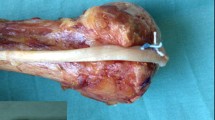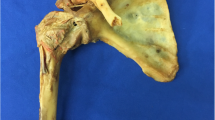Abstract
Introduction
The purpose of this study is to biomechanically evaluate a new technique of double knotless screw fixation for suprapectoral biceps tenodesis and compare the results with that of the single knotless screw fixation as well as the interference screw fixation.
Methods
24 fresh-frozen human cadaveric shoulders with a mean age of 68.3 ± 9 years were studied. The specimens were randomly divided into three experimental biceps tenodesis groups (n = 8): single knotless screw, double knotless screw and interference screw. Each tenodesis specimen was mounted on a mechanical testing machine, preloaded for 2 min at 5 N, tested with cyclic loading from 5 to 70 N for 500 load cycles and subjected to an axial load to failure test (1 mm/s). The ultimate failure load, stiffness, cyclic displacement and mode of failure were evaluated.
Results
The interference screw fixation had the highest ultimate failure load (215.8 ± 43.1 N) and stiffness (25.7 ± 5.2 N/mm) which were significantly higher than the corresponding results for the single and double knotless screw groups (P = 0.0029). The double knotless screw group had the second highest ultimate failure load (162.8 ± 13.8 N) and stiffness (15.1 ± 4.1 N/mm) which were significantly higher than the corresponding results for the single knotless screw technique (P = 0.0002). The most common mode of failure was suture slippage for both the double (7/8) and single knotless screw (6/8) groups while biceps tendon tearing occurred most often for the interference screw group (6/8).
Conclusion
In this biomechanical study, the double knotless screw fixation was found to have a significantly greater ultimate failure load and stiffness than the single knotless screw fixation but lower values than the interference screw fixation.





Similar content being viewed by others
References
Elser F, Braun S, Dewing CB, Giphart JE, Millett PJ (2011) Anatomy, function, injuries, and treatment of the long head of the biceps brachii tendon. Arthroscopy 27(4):581–592. https://doi.org/10.1016/j.arthro.2010.10.014
Jacxsens M, Granger EK, Tashjian RZ (2018) Clinical and sonographic evaluation of subpectoral biceps tenodesis with a dual suture anchor technique demonstrates improved outcomes and a low failure rate at a minimum 2-year follow-up. Arch Orthop Trauma Surg 138(1):63–72. https://doi.org/10.1007/s00402-017-2810-z
Lee HI, Shon MS, Koh KH, Lim TK, Heo J, Yoo JC (2014) Clinical and radiologic results of arthroscopic biceps tenodesis with suture anchor in the setting of rotator cuff tear. J Shoulder Elbow Surg 23(3):e53–e60. https://doi.org/10.1016/j.jse.2013.06.004
Wu PT, Jou IM, Yang CC, Lin CJ, Yang CY, Su FC, Su WR (2014) The severity of the long head biceps tendinopathy in patients with chronic rotator cuff tears: macroscopic versus microscopic results. J Shoulder Elbow Surg 23(8):1099–1106. https://doi.org/10.1016/j.jse.2013.11.013
Zhang Q, Zhou J, Ge H, Cheng B (2015) Tenotomy or tenodesis for long head biceps lesions in shoulders with reparable rotator cuff tears: a prospective randomised trial. Knee Surg Sports Traumatol Arthrosc 23(2):464–469. https://doi.org/10.1007/s00167-013-2587-8
Lee HJ, Jeong JY, Kim CK, Kim YS (2016) Surgical treatment of lesions of the long head of the biceps brachii tendon with rotator cuff tear: a prospective randomized clinical trial comparing the clinical results of tenotomy and tenodesis. J Shoulder Elbow Surg 25(7):1107–1114. https://doi.org/10.1016/j.jse.2016.02.006
Gurnani N, van Deurzen DF, Janmaat VT, van den Bekerom MP (2016) Tenotomy or tenodesis for pathology of the long head of the biceps brachii: a systematic review and meta-analysis. Knee Surg Sports Traumatol Arthrosc 24(12):3765–3771. https://doi.org/10.1007/s00167-015-3640-6
Shang X, Chen J, Chen S (2017) A meta-analysis comparing tenotomy and tenodesis for treating rotator cuff tears combined with long head of the biceps tendon lesions. PLoS One 12(10):e0185788. https://doi.org/10.1371/journal.pone.0185788
De Carli A, Vadala A, Zanzotto E, Zampar G, Vetrano M, Iorio R, Ferretti A (2012) Reparable rotator cuff tears with concomitant long-head biceps lesions: tenotomy or tenotomy/tenodesis? Knee Surg Sports Traumatol Arthrosc 20(12):2553–2558. https://doi.org/10.1007/s00167-012-1918-5
Cho NS, Cha SW, Rhee YG (2014) Funnel tenotomy versus intracuff tenodesis for lesions of the long head of the biceps tendon associated with rotator cuff tears. Am J Sports Med 42(5):1161–1168. https://doi.org/10.1177/0363546514523719
Mazzocca AD, Bicos J, Santangelo S, Romeo AA, Arciero RA (2005) The biomechanical evaluation of four fixation techniques for proximal biceps tenodesis. Arthroscopy 21(11):1296–1306. https://doi.org/10.1016/j.arthro.2005.08.008
Mazzocca AD, Rios CG, Romeo AA, Arciero RA (2005) Subpectoral biceps tenodesis with interference screw fixation. Arthroscopy 21(7):896. https://doi.org/10.1016/j.arthro.2005.04.002
Richards DP, Burkhart SS (2004) Arthroscopic-assisted biceps tenodesis for ruptures of the long head of biceps brachii: the cobra procedure. Arthroscopy 20 Suppl 2:201–207. https://doi.org/10.1016/j.arthro.2004.04.049
Shon MS, Koh KH, Lim TK, Lee SW, Park YE, Yoo JC (2013) Arthroscopic suture anchor tenodesis: loop-suture technique. Arthrosc Tech 2(2):e105-110. https://doi.org/10.1016/j.eats.2012.12.003
Su WR, Budoff JE, Chiang CH, Lee CJ, Lin CL (2013) Biomechanical study comparing biceps wedge tenodesis with other proximal long head of the biceps tenodesis techniques. Arthroscopy 29(9):1498–1505. https://doi.org/10.1016/j.arthro.2013.06.013
Saper D, Li X (2017) A simple, all-arthroscopic, knotless suture lasso loop technique for suprapectoral biceps tenodesis. Arthrosc Tech 6(3):e635-e639. https://doi.org/10.1016/j.eats.2017.01.008
Uschok S, Herrmann S, Pauly S, Perka C, Greiner S (2016) Combined arthroscopic tenodesis of the long head of biceps and rotator cuff repair in antero-superior cuff tears. Arch Orthop Trauma Surg 136(9):1273–1279. https://doi.org/10.1007/s00402-016-2498-5
Golish SR, Caldwell PE 3rd, Miller MD, Singanamala N, Ranawat AS, Treme G, Pearson SE, Costic R, Sekiya JK (2008) Interference screw versus suture anchor fixation for subpectoral tenodesis of the proximal biceps tendon: a cadaveric study. Arthroscopy 24(10):1103–1108. https://doi.org/10.1016/j.arthro.2008.05.005
Patzer T, Rundic JM, Bobrowitsch E, Olender GD, Hurschler C, Schofer MD (2011) Biomechanical comparison of arthroscopically performable techniques for suprapectoral biceps tenodesis. Arthroscopy 27(8):1036–1047. https://doi.org/10.1016/j.arthro.2011.03.082
Tashjian RZ, Henninger HB (2013) Biomechanical evaluation of subpectoral biceps tenodesis: dual suture anchor versus interference screw fixation. J Shoulder Elbow Surg 22(10):1408–1412. https://doi.org/10.1016/j.jse.2012.12.039
Patzer T, Santo G, Olender GD, Wellmann M, Hurschler C, Schofer MD (2012) Suprapectoral or subpectoral position for biceps tenodesis: biomechanical comparison of four different techniques in both positions. J Shoulder Elbow Surg 21(1):116–125. https://doi.org/10.1016/j.jse.2011.01.022
Song HS, Williams GR Jr (2012) All-arthroscopic biceps tenodesis by knotless winding suture. Arthrosc Tech 1(1):e43-46. https://doi.org/10.1016/j.eats.2012.01.002
Su WR, Ling FY, Hong CK, Chang CH, Chung KC, Jou IM (2015) An arthroscopic technique for long head of biceps tenodesis with double knotless screw. Arthrosc Tech 4(4):e375-378. https://doi.org/10.1016/j.eats.2015.03.023
Krackow KA, Thomas SC, Jones LC (1986) A new stitch for ligament-tendon fixation. Brief note. J Bone Jt Surg Am 68(5):764–766
Slabaugh MA, Frank RM, Van Thiel GS, Bell RM, Wang VM, Trenhaile S, Provencher MT, Romeo AA, Verma NN (2011) Biceps tenodesis with interference screw fixation: a biomechanical comparison of screw length and diameter. Arthroscopy 27(2):161–166. https://doi.org/10.1016/j.arthro.2010.07.004
El-Azab H, Buchmann S, Beitzel K, Waldt S, Imhoff AB (2010) Clinical and structural evaluation of arthroscopic double-row suture-bridge rotator cuff repair: early results of a novel technique. Knee Surg Sports Traumatol Arthrosc 18(12):1730–1737. https://doi.org/10.1007/s00167-010-1257-3
Garofalo R, Mocci A, Moretti B, Callari E, Di Giacomo G, Theumann N, Cikes A, Mouhsine E (2005) Arthroscopic treatment of anterior shoulder instability using knotless suture anchors. Arthroscopy 21(11):1283–1289. https://doi.org/10.1016/j.arthro.2005.08.033
Ng DZ, Kumar VP (2014) Arthroscopic Bankart repair using knot-tying versus knotless suture anchors: is there a difference? Arthroscopy 30(4):422–427. https://doi.org/10.1016/j.arthro.2014.01.005
Vaishnav S, Millett PJ (2010) Arthroscopic rotator cuff repair: scientific rationale, surgical technique, and early clinical and functional results of a knotless self-reinforcing double-row rotator cuff repair system. J Shoulder Elbow Surg 19(2 Suppl):83–90. https://doi.org/10.1016/j.jse.2009.12.012
Kaback LA, Gowda AL, Paller D, Green A, Blaine T (2015) Long head biceps tenodesis with a knotless cinch suture anchor: a biomechanical analysis. Arthroscopy 31(5):831–835. https://doi.org/10.1016/j.arthro.2014.11.043
Lorbach O, Trennheuser C, Kohn D, Anagnostakos K (2016) The biomechanical performance of a new forked knotless biceps tenodesis compared to a knotless and suture anchor tenodesis. Knee Surg Sports Traumatol Arthrosc 24(7):2174–2180. https://doi.org/10.1007/s00167-014-3365-y
Kusma M, Dienst M, Eckert J, Steimer O, Kohn D (2008) Tenodesis of the long head of biceps brachii: cyclic testing of five methods of fixation in a porcine model. J Shoulder Elbow Surg 17(6):967–973. https://doi.org/10.1016/j.jse.2008.03.001
Lafosse L, Van Raebroeckx A, Brzoska R (2006) A new technique to improve tissue grip: “the lasso-loop stitch”. Arthroscopy 22(11):1246 e1241–e1243. https://doi.org/10.1016/j.arthro.2006.05.021
Funding
There is no funding source.
Author information
Authors and Affiliations
Corresponding author
Ethics declarations
Conflict of interest
The authors declare that they have no conflict of interest.
Ethical approval
This article was granted an exemption from the institutional review board (IRB) in a medical center.
Rights and permissions
About this article
Cite this article
Hong, CK., Chang, CH., Chiang, F.L. et al. Biomechanical properties of suprapectoral biceps tenodesis: double knotless screw fixation is superior to single knotless screw fixation. Arch Orthop Trauma Surg 138, 1127–1134 (2018). https://doi.org/10.1007/s00402-018-2927-8
Received:
Published:
Issue Date:
DOI: https://doi.org/10.1007/s00402-018-2927-8




